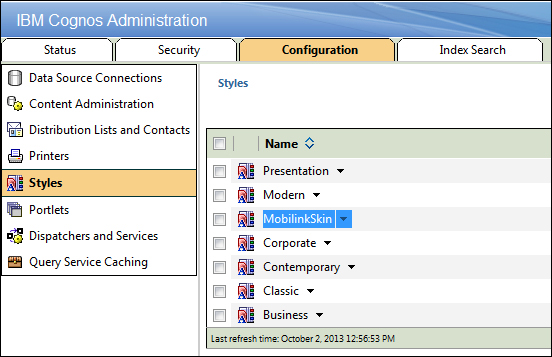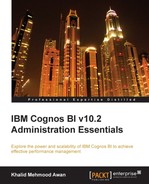When it comes to user experience, the graphical user interface plays a major role in bringing about a good user experience. Since the very start of Cognos BI, the Cognos BI application developers focused on attaining a much better user experience by providing some excellent and advanced features. These features not only help in quick content management, but also provide a very user-friendly environment. In this chapter we will introduce the additional features that Cognos has along with the customization of the Cognos environment. The following topics will be covered in this chapter:
- Customizing appearance
- Customizing functionality
- Portlets administration
- Managing user profiles
Cognos provides a professional web interface where all the studios are web-based. This includes Query Studio, Report Studio, Event Studio, Analysis Studio, Cognos Workspace, Cognos Workspace Advanced, and much more. Of course, there is Cognos Connection as well as Cognos Administration Portal. The Cognos BI environment provides flexibility and adaptability to change almost all the appearance sections of the studios and connections, as per the requirements of different organizations. For example, a company would always want the company logo next to each professional business report. A company has a color scheme, font styles, sizes, images, and a logo that apply to the company's official website, internal portals, and even the company letter heads and employee visiting cards.
IBM Cognos BI provides some built-in styles (CSS, skins). Once applied globally by an administrator, it changes the global look and feel of almost all the sections (studios, connections, Admin Portal). The IBM Cognos BI administrator may change the default style by altering the Styles section of the default user preferences from the Cognos namespace residing in the Security tab. Cognos BI also provides the flexibility to add custom styles (containing custom colors, fonts, images, and so on). The following screenshot shows some of the different predefined styles available:

Styles may also be changed from the style management utility, which is located on each Cognos BI Gateway. A custom style may be created by duplicating the existing style and editing it. When a user logs in for the first time, a default style is tagged for this user and is hardcoded, unless the user manually changes it. If you disable all styles except the preferred style, the user cannot change the style as there is only one style available. Therefore, the administrator must apply the company style prior to allowing access to users. Otherwise, it will be very difficult to change the style company wide. When no other style is available, Cognos BI uses the Corporate style. The following screenshot shows the Cognos namespace's default Cognos user preferences section with the company style selected as default for all new users:

A detailed procedure for customizing the Cognos styles is available on the Cognos website, where every section is discussed separately.
Note
The following link points to the IBM Cognos BI 10.2 documentation homepage:
http://pic.dhe.ibm.com/infocenter/cbi/v10r2m0/index.jsp
Try searching for Customizing the Appearance of Cognos.
The following steps briefly explain how a custom Cognos style can be created:
- Select an existing style that best suits your choice. The style management utility may be used for this purpose. Rename this style, for example, the company name along with the directory location in the skins directory.
- Custom fonts, CSS, images, and layout properties may be included. Refer to the file located at
c10_location/webcontent/skins/style. The CSS file usually contains the details of fonts, colors, and so on. Also, a lot of the changes are made using XML. - In IBM Cognos Administration Portal, under the Configurations tab, create a new style item and provide the relative path to the directory created earlier.
- Once a style has been created, it can be used as a default user style by selecting it in the Default User Preferences settings. These settings are located under the Security tab in the Cognos namespace.
Cognos BI also provides a command-line-based utility to manage styles. The gateway servers contain this utility that is located at the Cognos installation path. Once the styles are created, they can be used as the basis for creating other custom styles. Once the custom styles are created using this utility, XML files may be used to make global customizations to the appearance of the Cognos Connection and Administration portals. XML validation is also performed by this utility. Once these files are created, they are saved to Content Manager. Once published, these styles are visible to users. The following steps show you how to create and deploy a custom style using this utility for Cognos Administration:
- Create a custom style: You can create a custom style that is based on one of the predefined styles provided by IBM Cognos BI.
- Modify the style.xml file: When you create a new style, changes to Cognos Connection and Cognos Administration can be made via the
style.xmlfile located atc10_location/temp. - Generate the custom style: The utility creates a temporary folder at
c10_location/tempfor the new style. This folder contains the files necessary for the new style, including CSS and images. For the IBM Cognos Connection and Administration portals, the style changes are updated dynamically by the utility. Fonts and layout properties can be changed by manually changing the.cssfiles. - Deploy the style: To deploy a style, create a folder and move all the
.css, images, and.xmlfiles to your desired style name folder and move this folder toc10_locationwebcontentskinson all the gateway locations. - Publish the custom style: By performing this step, the style becomes available to all users to use and appears in the list of styles in IBM Cognos Connection. This is done by the administrator adding the style from Cognos Administration Portal. The name and relative path to the style folder are provided.
